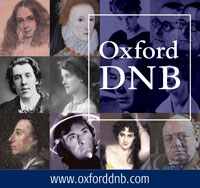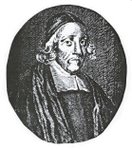2007-01-30
Aspects of Piety 04
Lectureships, especially popular in London, were a Puritan attempt to promote preaching. ‘These lecturers (almost entirely called and supported the laity) created a situation in which much of the preaching in the city took place outside of normal ecclesiastical lines of authority’ (Mark Dever, Richard Sibbes Puritanism and Calvinism in late Elizabethan and early Stuart England, p 81). A full study can be found in Seaver.
During the Wingrave years, Adams published several collections of sermons and was in demand as a popular city preacher. He retained his lectureship at St Gregory’s until at least 1623, but as, following the Synod of Dort, King James became increasingly pro-Arminian and discouraged lectureships (even before Laud began outlawing them), this probably came to an end.
Still much in demand, he preached his final sermons at Paul’s Cross in 1623 and 1624. The Temple commemorated King James’s preservation from the gunpowder plot. Three Sermons, 1625, suggests continued prominence as it includes sermons for the Lord Mayor’s election, the triennial visitation of the Bishop of London and mourners at Whitehall two days after King James’s death.
Labels: Aspects of piety, Biography 0 comments
2007-01-29
Aspects of Piety 03
It is difficult at this remove to appreciate how popular preaching and printed sermons were in the 17th Century. The reading public was far greater than historians once thought and there was a flood of literature of all sorts to sate its appetite. This flood inevitably spilled over and affected more illiterate sections of the population too. Alexandra Walsham (Providence in early modern England p 33) has written of
an explosion of cheaply priced printed texts designed to entertain, edify, and satisfy the thirst of a rapidly expanding reading public for information. … Hawked and chanted at the doors of theatres, alehouses, and other habitual meeting spots, and displayed for sale in shops in the vicinity of St Paul’s churchyard, they also penetrated the provinces and countryside to a degree which is only gradually coming to light.
The nation’s preachers seem initially simply to have bewailed this flood of largely unhelpful literature. Then, reluctantly at first, they began to swell it with the most wholesome material they could produce in various formats, from cheap unbound booklets to high quality folio editions. An incentive to putting sermons into print was the fact that unscrupulous printers might otherwise produce pirated and potentially inaccurate editions, so great was the demand for such material. While sermons undoubtedly held little attraction for some, there was a sizable number for whom ‘they were like an addictive and intoxicating drug’. (Walsham p 61)
Perhaps especially in London preaching was as much a communal gathering as a solemn spiritual event, to which restive and wayward youth eagerly swarmed.
In general, both hearers of preaching and readers of sermons were many and varied. (Walsham, p 62). Adams complains of ‘perfunctory hearing’, (Works 2, p 271) and asks ‘How many sermons are lost whiles you bring not with you the vials of attention.’ ‘You come frequently to the wells of life,’ he complains ‘but you bring no pitchers with you.’ The people either lack mouths to receive the balm of grace or bottoms to retain it. (Works 3, p 366) He also says '… never did the Egyptians call so fast upon the Israelites for making of bricks, as the people call on us for the making of sermons; (Cf Works 2, p 169). Typically, he cannot resist adding ‘and our allowance of materials is much alike’! He asks of London ‘What city in the world is so rich in her spiritual provision as this? Some whole countries within the Christian pale have not so many learned and painful pastors as be within these walls and liberties.’ (Works 2, p 271) Paul Seaver has commented ‘In its preaching, as in so many other respects, London was without rival. Nowhere else were there so many lectureships packed into so small an area ….’ (The Puritan lectureships the politics of religious dissent 1560-1662 p 121)
Adams was one of many who sought to capitalise on this interest through printed sermons. Various means were used to reduce sermons to print. We do not know what happened in Adams’ case but judging from the presentation of the material and its general lack of literary (as opposed to homiletical) polish, it would seem that amanuenses were employed to record Adams’ sermons verbatim. (Cf ‘I know you have long looked for an end; I never delighted in prolixity.’
His sermons vary in length. Possibly material was added. Sensitive to accusations of simply affecting to be a man in print, in 1630 he rehearses a popular argument for printing sermons in his dedication ‘to the candid and ingenious reader’.
Speech is only for presence, writings have their use in absence … our books may come to be seen where ourselves shall never be heard. These may preach when the author cannot, and (which is more) when he is not.
Labels: Aspects of piety, Biography 0 comments
2007-01-28
Aspects of Piety 02
Our ignorance is so great that we know neither where or when he was born, nor when he died. The ODNB guesses 1583-1652.
We also know that at some point he married and had a son and two daughters, the latter predeceasing him in 1642 and 1647. Probably he was born in the early 1580s, in the reign of Elizabeth I. (It is clear from his occasional references to her that Adams respected good Queen Bess and King James too). As for his death, we know that in 1652 he was in ‘necessitous and decrepit old age’. (Cf Works 3, pp lvi and 264). It would seem that he ‘relied upon the charity of his former parishioners during the final months of his life’ which presumably came while in his seventies, before the Restoration of 1660.
A further known date is his ordination in the Diocese of Lincoln in 1604, the year after James came to the throne. The following year Adams was licensed to the curacy of Northill, Bedfordshire, but was soon dismissed when Northill College Manor was sold. (See here). By 1611 it seems he was vicar in the village of Willington, near Bedford, where he remained until 1614, pursuing a ministry of preaching and putting sermons into print. (See here). While at Willington, he preached at least once before the Bedford clergy at an Archdeacon’s visitation and twice from Paul’s Cross. These sermons were published, as was the common practice at the time. So even as a young man his sermons were being published
Labels: Aspects of piety, Biography 0 comments
2007-01-27
Paul's Wharf
| http://en.wikipedia.org/wiki/User:ChrisO |
Labels: Biography, St Benet Paul's Wharf 0 comments
Willington

St Laurence , Willington, Bedfordshire, where Adams served 1612-1614
stables and
dovecote there,
built in 1541.
Labels: Biography, Willington 0 comments
Aspects of Piety 01
But when the gospel came to us in Queen Elizabeth’s days, of so blessed memory, we also had much peace. We had with Gloria in ex celsis Deo, sung also Pax in terris. The iron gates of war were shut up, and the long tossed ark of our church had an olive-branch of flourishing peace bestowed upon it. The fury of an adversary was not known, but ‘righteousness and peace kissed each other.’ Yet was not this peace without great fires:
1. There was a great fire of Anabaptism: a gross, perverse, and sottish sect, that had washed off their font-water as unclean, and thought it not enough to run out of Babylon, unless they ran also out of themselves, out of their wits. …
2. There was a great fire of Brownism: an ignis fatuus, fastening on abundance of crude and squalid matter, that could not easily be extinguished. It was blown up with the bellows of pride; and because it might not have its own swing, it fell to direct railing. They say the church of England may be their mother, but is none of God’s wife. Why do they not call her plain ‘whore?’ for such is a mother that hath children, and no husband. But these the whiles are brave sons, who care not to prove themselves bastards, that their mother may be noted for a harlot. But the shame be their own, integrity hers; who hath not defiled her bed, though they have shamed her womb. …
3. There was a raging fire of the Papists; who to maintain their spiritual fire of superstition, made use of material fire to set a whole land in combustion. How unspeakable were their treasons against that gracious princess! which yet if we gather up into one volume, we shall find their last equalling all: which should have been a fire, a fire indeed, such a one as hell itself could only belch out. But bless we our God, that with sweet showers of mercy rained it out.
These fires have been kindled in a land of peace, though many tears have been showered upon them, and earnest prayers sent up to heaven for their quenching. Yea, and will be still, so long as that crown-shorn generation can transport their burning quills into England; and their great Antichrist, the successor not of Peter, but of Romulus, sits on that fiery chair. …
{See Works of Thomas Adams 2, p 152}
With well over a million words in print, (besides the sermons in the collected Works there is a massive Commentary on the Second Epistle General of Peter) he is a bright star in a veritable galaxy of 17th Century divines whose reputation today rests chiefly in their literary output. In his own day, Adams was often quoted in commonplace books. (Works 3, p x. Referring to the Library of William Bentley, preserved in Alleghenny College, Edwin Wolf says interestingly ‘He did own, as did most colonial Americans who had a shelf of folios, Foxe’s Book of Martyrs, the works of Thomas Adams, … the sermons of Lancelot Andrewes’. See here.) Today he is largely forgotten but his works are still available and are still quoted. In the book by I D E Thomas, A Puritan Golden Treasury (Edinburgh, Banner of Truth Trust, 1977) of 145 Puritans quoted, Adams is cited more than most. Only the later eminently quotable William Gurnall (1617-1679) and Thomas Watson (c1620-1686) appear to have provided more material.
Labels: Aspects of piety, Biography 2 comments
More sermons
Another collection of 12 sermons can be found here on Google Books. This edition is from 1847. The sermons are as follows
1. The Three Divine Sisters: Faith, hope, and Charity
2. The Leaven; or, A Direction to Heaven.
3. A Crucifix; or, A Sermon upon the Passion,
4. Semper Idem; or The Immutability of Jesus Christ
5. Heaven's Gate; or, The Passage to Paradise
6. Majesty in Misery; or the Power of Christ even dying
7. The Fool and his Sport
8. The Christian's Walk; or the King;s Highway of Charity
9. Love's Copy; or, The Best Precedent of Charity
10. God's Bounty; or The Blessings of Both his Hands
11. Politic hunting
12. The Taming of the Tongue
Labels: Sermons 0 comments
Sermons
I. The City of Peace
II. The Fatal Banquet
III. The Breaking-up of the Feast
IV. God's Bounty
V. Politic Hunting
VI. Heaven made Sure
VII. The Sinner's Passing-Bell
VIII. God's House
IX. The Sinner's Mourning-Habit
X. The Cosmopolite
XI. The Two Sons
XII. The Soul's Sickness
Labels: Sermons 0 comments
Three Divine Sisters
 A sermon of Adams
A sermon of Adams
The Three Divine Sisters: Faith, Hope and Charity
can be found here on Google Books.
Enter search 'Thomas Adams'.
The sermon is on p 179. The book, by H C Fish, is called
History and Repository of Pulpit Eloquence
Labels: Sermons, Three Divine Sisters 0 comments
Literary Biography
A literary essay on Thomas Adams can be found here
Labels: Biography, Link, Moira P Baker 0 comments
ODNB Entry

innumerable swarmes of … men and women, whose whole imployment is, to goe from their beds to the Tap-house, then to the Play-house, where they make a match for the Brothel-house, and from thence to bed againe … What an armie of these might bee mustred out of our Suburbs? (The Barren Tree, 1623, 48–9
When James I sought a Spanish marriage for Prince Charles, Adams denounced ‘the Romish Idols’ and Solomon's disastrous love of ‘idolatrous women’; he concluded that ‘when Religion and Superstition meet in one bed, they commonly produce a mungrell generation’ (The Temple, 1624, 34–5). Unlike puritans, however, he endorsed kneeling to receive communion and castigated the ‘fond scrupulositie’ of those who demanded such a rigid ‘conformitie to the primitive times, as if the Spouse of Christ might not weare a lace or a border, for which she could not plead prescription’. For Adams the outcome of the abolition of episcopacy that some puritans sought would have been a nightmarish ‘Anabaptisticall ataxie or confusion’ (Works, 931, 933).
Labels: Biography 0 comments
Disambiguation
Labels: Biography, Disambiguation 0 comments
Britannica 1911
Labels: Biography 0 comments
















